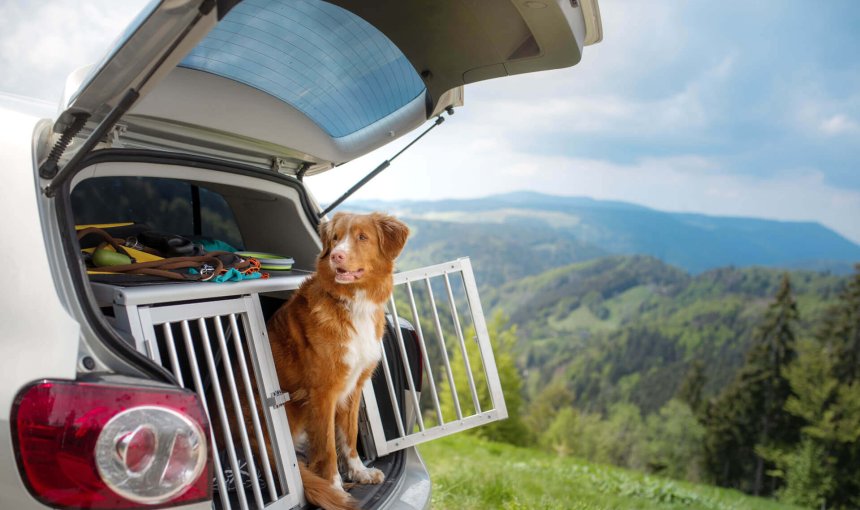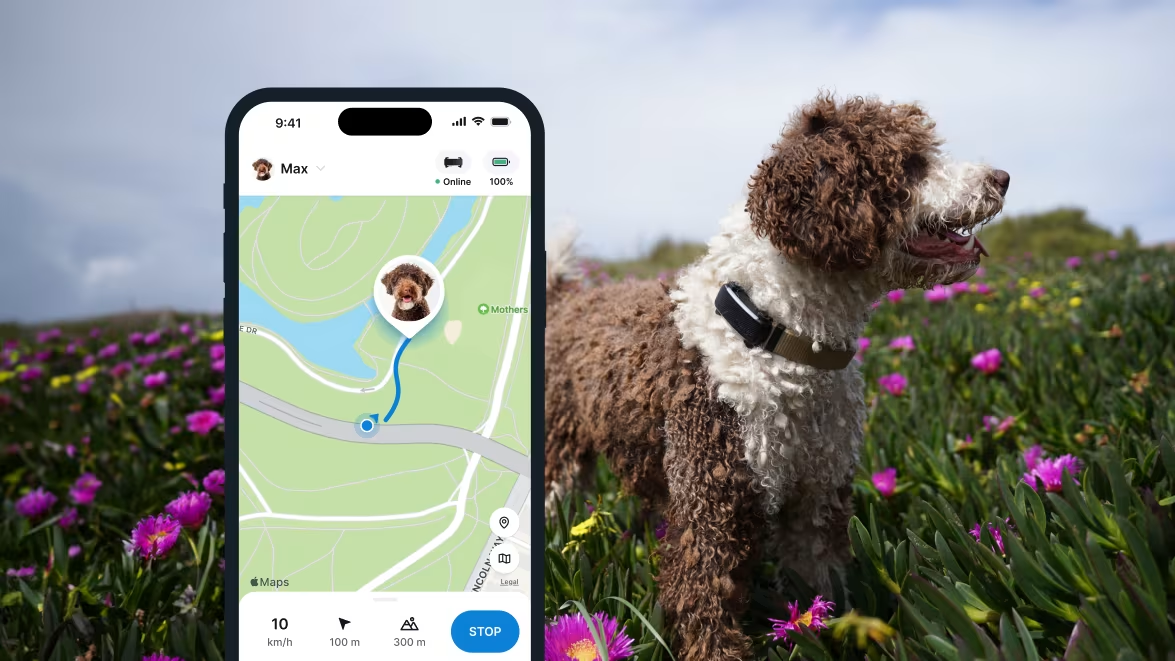How To Travel With A Dog: Tips For A Fun Road Journey
Ready to hit the road with your dog? Not so fast. When driving with a dog it's important to restrain your furry buddy and follow these safety tips for the best possible outcome on your road trip together.

As a loving dog parent, you want your buddy as close as possible at all times, even when on the road and on the move. But you might’ve wondered, how to travel with a dog – without utterly losing your mind? (Or your dog?) Here we’ve gathered some dog car travel safety tips to keep your buddy protected as you both ride off into the sunset. (Including the escape-proof bit of tech that’ll prevent you from ever losing them while on vacation.)
Key Takeaways
Safety is the top priority.
Always safely restrain your dog in the car to prevent injury in case of a sudden stop or accident. Use a car harness, tether, crate, or booster seat.
Practice makes perfect.
Start with short practice rides to help your dog get used to the car and associate it with positive experiences.
You should absolutely avoid…
Letting your dog sit in the front passenger seat or on a driver’s lap, ride in an open pickup truck bed, or sticking their head out the window. Also, never leave a dog in a parked car.
Use a smart dog tracker as an emergency measure.
Your Tractive device provides real-time tracking with an unlimited range to help you find your dog if they escape from the car – all with just a glance at your phone.

Always know your buddy is healthy & safe
Read moreHow to travel with a dog by car: Getting started
If a pet sitter or boarding aren’t options, why not just take your buddy along on your trips? Here are a couple of tips on how to get them used to traveling with you, by car, for starters. (Else, check out our post on flying with dogs for the next step.)
Start with short practice car rides
You might be socializing your puppy to new pets, people, and places – so how about your car? Short practice car rides can get them used to this “new” environment and learn that car travel is fun, rewarding, and 100% safe. Take short car trips around your neighborhood – and eventually your wider town – to places your dog enjoys, like the park, a hiking trail, or to visit a friend or loved one.
Ideally, you want to mix up your visits. Your car rides will also take your buddy to less “fun” places, like the vet’s – so you want to ensure they aren’t only riding in your car when off to somewhere scary! This will actually build a negative association with your car instead. Keep some treats at hand and offer a ton of pets, praise, and playtime after.
Use a gentle restraint for your dog in the car
Always gently restrain your dog while in a moving car. In the end, you can never predict what others are going to do (or not do!) on the road. Meaning, you may need to slam your brakes or swerve quickly to avoid an accident. In these cases, an unrestrained dog might be hurled forward and could end up seriously hurt.
Some states in the U.S., all of the United Kingdom, and most of Australia require by law that dogs must be restrained while in a car. Other localities can penalize drivers if a dog is unrestrained in a vehicle because this is considered a distraction. Your vet or local animal shelter can help you navigate local laws and ordinances related to dog restraints.
💡We cover a few options for safe car seats for dogs a little further below.
Avoid keeping your dog in…
- Your lap. Yes, we know it’s cute with your buddy with their paws on the steering wheel – but it’s another big no-no. Just imagine what’ll happen if you suddenly need to hit the brakes or get rear-ended?
- The front passenger seat, primarily because your dog will end up distracting both you and other drivers. Besides, if you do get in an accident, your car’s airbags are built to protect humans – not dogs (or kids under the age of 13) – and might end up injuring or even killing them!
- The open bed of a pickup truck. Your dog could be tossed out of the truck bed during a sharp turn or leap out of the truck onto the road. If you must keep your dog in the truck bed, double-tether them so they remain in the center and cannot move across the truck bed.
- As for convertibles, crate or securely tether your dog to avoid dangerous accidents.
We’d also recommend you only let your dog ride shotgun if your car doesn’t have airbags – or if they’re restrained somehow.
Don’t let your buddy stick their head out the window
If you wouldn’t let your kids do it, why let your dog do it? Your buddy’s head might end up hitting mailboxes, sign posts, or even flying debris! The better option is to roll the window down a crack to allow fresh air to enter. Or install a window guard that lets you open the window while blocking your dog from sticking their head out.
Safe car seats for dogs
Now if you’re wondering how to travel with a dog with all these safety concerns, we’ve got you. Here are a couple of ways to gently restrain your buddy while in a car so you can prevent accidents and keep them safe.
Try a dog car harness or tether
Medium- to large-sized dogs might need a bigger crate – which might not be the comfiest option for a car. So we’d recommend you get them a seatbelt-friendly harness or tether instead. A car harness for dogs typically has loops for seat belts to run through. Choose a harness with thick, padded straps for comfort.
If you’re using a tether instead, it should be short and attach at the dog’s back, not the neck. If your car has front passenger airbags, keep your dog in the back seat. As a general rule of thumb, your dog should be able to sit or lie down comfortably while harnessed or tethered.
Use a crate or a car dog barrier
A dog crate is another good option while traveling with dogs. (Especially younger or smaller ones.) Just remember: the crate should be big enough for your dog to stand, sit, turn around, and lie down in.
Make sure the crate can sit flat in your vehicle. If you place the crate in the back seat, tuck a rolled-up towel under the crate to level it. Run the seat belt through the crate handle or tie it down to keep it from sliding around. In a minivan or SUV, place the crate in the far back of the vehicle. However, avoid putting a crate in the trunk of a sedan-style car. Place a favorite towel or blanket in the crate to make it feel like home.
Car dog barriers are made of fence-like metal bars, sit behind the front or rear seats of your car, and reach to the ceiling. These are best for containing large dogs, who can better stabilize themselves during turns and quick stops.
⚠️ Just make sure to plan plenty of breaks while driving so you aren’t confining your buddy to a crate for longer than a few hours. They need regular breaks outdoors for some walking, stretching, feeding, and definitely toilet time!
Try a booster seat or dog car seat
A booster seat or dog car seat is a great option for small dogs and puppies. The seat is an open-topped box that is secured to the vehicle’s seat by straps. Choose a soft-sided canvas seat or a deluxe upholstered model. You can adjust the height of some seats to allow your dog to see out the window while sitting upright. When your pup is tired, they can curl up in the seat for a nap.
How to troubleshoot common travel challenges
Now when it comes to traveling with dogs by car, it’s possible you might run into a few of these challenges. Which is where regular practice and training much in advance can be a lifesaver – especially if your buddy isn’t used to being around cars.
So here’s how you can deal with:
Excessive barking
Get your dog used to traveling by car with short, practice drives around your neighborhood. With a few weeks of regular practice, this can help your buddy understand that car trips are fun and rewarding – not necessarily only to the vet’s clinic! Likewise, basic training commands (like “Stay” or “Wait”) can help your buddy curb their excitement and stay inside their car seat or tether.
If your dog isn’t a fan of being restrained, regular harness training can help them learn to get used to the “snug” feeling. With time, you can also introduce a crate to slowly get your buddy used to it.
Car sickness
Car sickness can be an issue for some dogs, especially puppies. If your puppy gets nauseous during car rides, put plastic sheeting on the car seat and bring old towels for clean ups. Start with short car trips and work up to longer excursions. Many puppies outgrow their car sickness, but you may need to be patient as they get acclimated to being in a moving vehicle.
Feed your dog a few hours before leaving on longer rad trips. A small amount of kibble and water at each rest stop can also help. (And take plenty of rests!) A pre-travel walk (or playtime) can also help reduce anxiety in your dog.
Finally, keep the window open a few inches to allow fresh air to enter, which can help alleviate car sickness. Don’t open the window far enough to allow your pup to stick their head out the window.
Dangers to dogs in parked cars
Maybe you’re in a hurry, or think that your pup will be just fine if you park under a tree. But a dog locked in a closed car, even with the windows partially open, is in grave danger of overheating. And in the worst case scenario, heat stroke in dogs can be fatal!

More tips on how to travel with a dog – for max safety
When in doubt, always think of what you’d do if you were traveling with kids – turns out, keeping your dog’s needs in mind isn’t too different!
Which is why we’d recommend you:
Go well- (and in fact, extra) equipped
If you’re headed out of town, plan ahead so you won’t encounter surprises. Check ahead for dog-friendly rest areas, hotels, parks, and campsites you can stop at. If you’re staying at a hotel, make sure to check their pet policies much in advance. Bring food, water, and your dog’s favorite toys. A collapsible water bowl can come in handy while traveling.
If your pup is on medication, bring extra in case your return is delayed. If you travel long distance or across the border, bring along your pet’s vaccination record and a dog first-aid kit for emergencies.
Take frequent breaks when on long car journeys
Everyone enjoys a break after a few hours in the car, including your dog. In fact, some rest areas include small fenced dog parks where your buddy can stretch their legs and relieve themselves, if need be. Find rest areas at two-hour intervals along your route. Keep your disposable gloves and some plastic bags ready in case your buddy needs to go to the toilet.
At each stop, give your dog fresh water and a light snack. Be sure to leash your dog before exiting the vehicle to avoid escapes.
Make sure your dog is easy to identify
Make sure your pup is wearing a collar or harness with ID tags. All of these can help keep them safe in case they wander off a bit too far, exploring this “new” area – helping someone else identify them (and you as the owner.) Ideally, you’ve also gotten your dog microchipped. This can help a vet or animal shelter identify your dog in case their ID tag or collar fall off or get lost – and then get in touch with you.
⚠️ Just remember: simply being able to identify your dog isn’t a guarantee you’ll find them again. Neither microchips nor ID tags can help you actually find your dog. They only work to identify your dog as belonging to someone. (So not a stray.) Rather, you’ll have to hope and pray your buddy runs into someone who’ll actually try and return them to you.
💡That’s where a smart dog tracker with real-time GPS tracking can be a lifesaver – so you can follow your buddy’s every step, as they make their every step.




